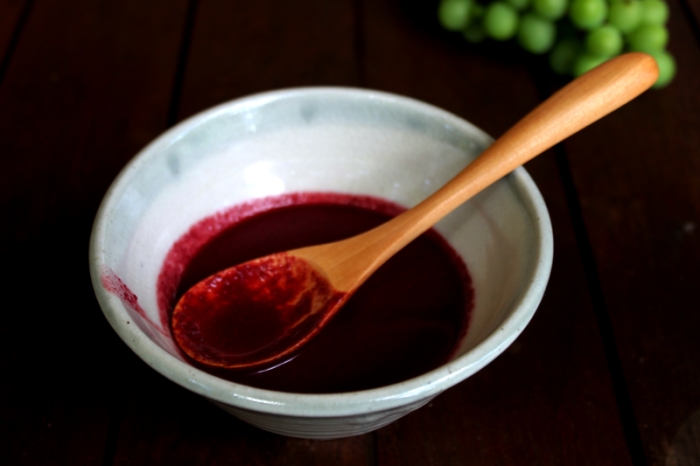This fortnight’s challenge “Something Borrowed, Something Blue” was one of the hardest challenges to find something to make. I really wanted to do something blue, but blue foods are always a bit thin on the ground. The exception seems to be the Middle Ages when a range of colourants were used to dye foods: saffron or egg yolk for yellow, alkanet, blood or berries for reds, ground toast or liver for browns and blacks, spinach or parsley juice for green and almond milk and chicken for white.[1] To make blue medieval cooks had a range of options: ground lapis lazuli (don’t try this at home!), cooked carrot peel, blackberries, cherry or grape juice, or the rather enigmatic turnsole[2].
Many of these ingredients were used in jellies or leaches (milk jellies) to produce fanciful, multi-coloured dishes. Another popular use was coloured sauces, The Medieval Kitchen: Recipes from France and Italy lists white, green, yellow, pink, black, blue and camel-coloured sauces.[3]
The Recipe
The pleasant-sounding ‘Sky-blue sauce for summer’ (I’ve also seen it translated as ‘heavenly’ which I think is even nicer) seemed promising. I don’t speak Italian so I used an English translation (from The Medieval Kitchen) but an Italian version is available here called ‘Sapor celeste de estate’.
“Sky-blue sauce for summer. Take some of the wild blackberries that grow in hedgerows and some thoroughly pounded almonds, with a little ginger. And moisten these things with verjuice and strain through a sieve.”[4]
Unfortunately, as you may have guessed from the pictures there was a major problem with my version, it’s not blue. To add insult to injury, it also tastes pretty awful (it somehow managed to be both too watery and too sour at the same time). Because of these rather major faults I won’t be giving a redaction (if you want to try it you can find the redaction from the book here). I used similar proportions, although I halved the recipe and used slightly less verjuice. I do wonder if that was the problem, although having had a look at some other blogs it seems that no-one has really succeeded at turning the recipe blue, let alone “a lovely midnight-blue”[5].
The Round-up
The Recipe: Sky-blue sauce for summer from Libro de Arte Coquinaria by Martino de Rossi (available here in Italian)
The Date: c. 1465
How did you make it?: I mashed 2 cups of blackberries then added the 2 tbsp of ground almonds, 1/2 tsp of ground ginger and 1/4 cup of verjuice before straining the mixture.
Time to complete?: About 20 mins.
How successful was it?: Well it didn’t turn blue and didn’t taste good so it failed on pretty much all counts. Whether the taste was correct but just not my thing I’m not sure. As to not turning blue, I wonder if either I didn’t add enough verjuice or it wasn’t acidic enough. Epulario by Giovanne Roselli has a nearly identical recipe but he uses mulberries instead, would this work better?
How accurate?: I wonder what medieval verjuice was like, something to investigate further.
[1] Terence Scully, The Art of Cookery in the Middle Ages, 5th ed. (Suffolk and Rochester: Boydell Press, 2006), 114–116.
[2] Turnsole is a dyestuff that yields a colour that varies from red to purple to blue depending on the PH level of the liquid it is mixed with. It has been identified as several different plants, although the most likely is chrozophora tinctoria.
[3] Odine Redon, Francoise Sabban, and Silvano Serventi, The Medieval Kitchen: Recipe from France and Italy, trans. Edward Schneider (Chicago & London: The University of Chicago Press, 1998), 165–178.
[4] Ibid., 168.
[5] Ibid.
Bibliography
Redon, Odine, Francoise Sabban, and Silvano Serventi. The Medieval Kitchen: Recipe from France and Italy. Translated by Edward Schneider. Chicago & London: The University of Chicago Press, 1998.
Scully, Terence. The Art of Cookery in the Middle Ages. 5th ed. Suffolk and Rochester: Boydell Press, 2006.


Lina says:
I also made the ‘Sapor celeste de estate’ for the HFF, and I also got a red, instead of blue, sauce. But I think now it’s just a translation error: I tried to translate this strange medieval Latin and ‘Sapor celeste de estate’ is just ‘Heavenly summer sauce’, there’s no ‘blue’ or ‘sky-blue’ in the title. But for fun I tried to make the sauce blue with baking and washing soda! 🙂
http://www.sewhistorically.com/heavenly-sky-blue-or-blood-red-summer-sauce-historical-food-fortnightly/
September 27, 2016 — 12:37 pm